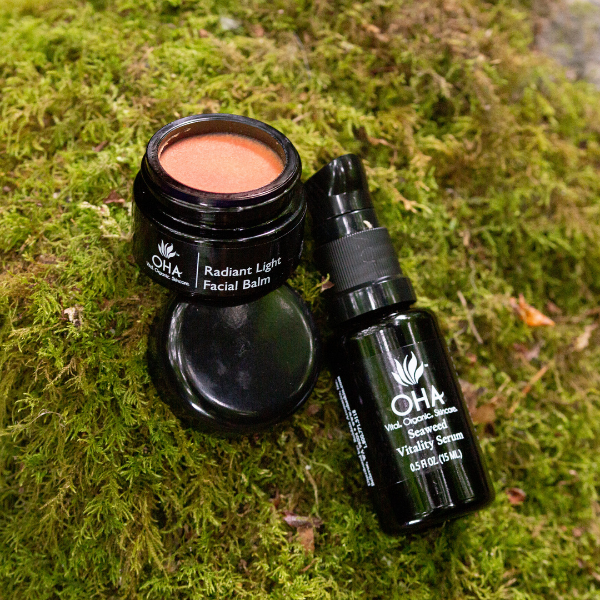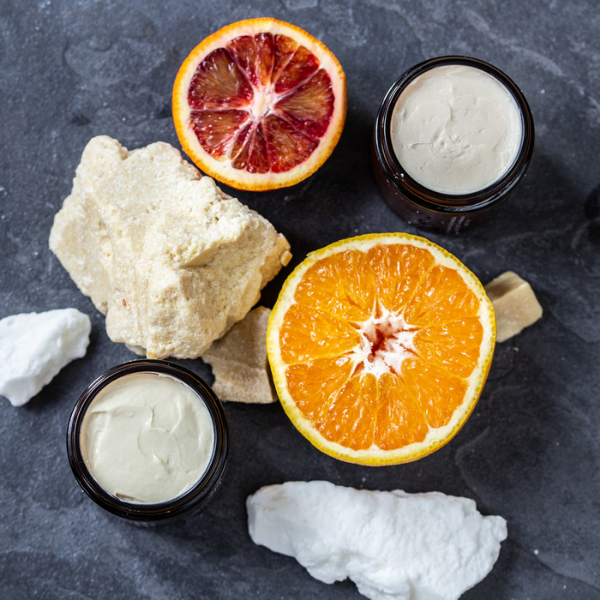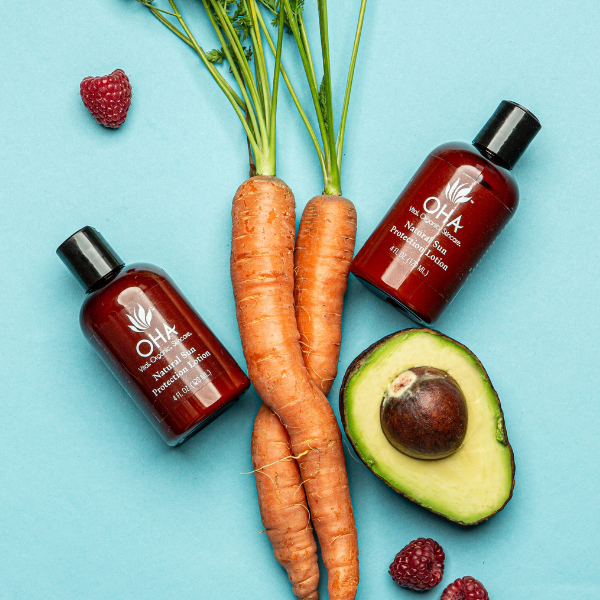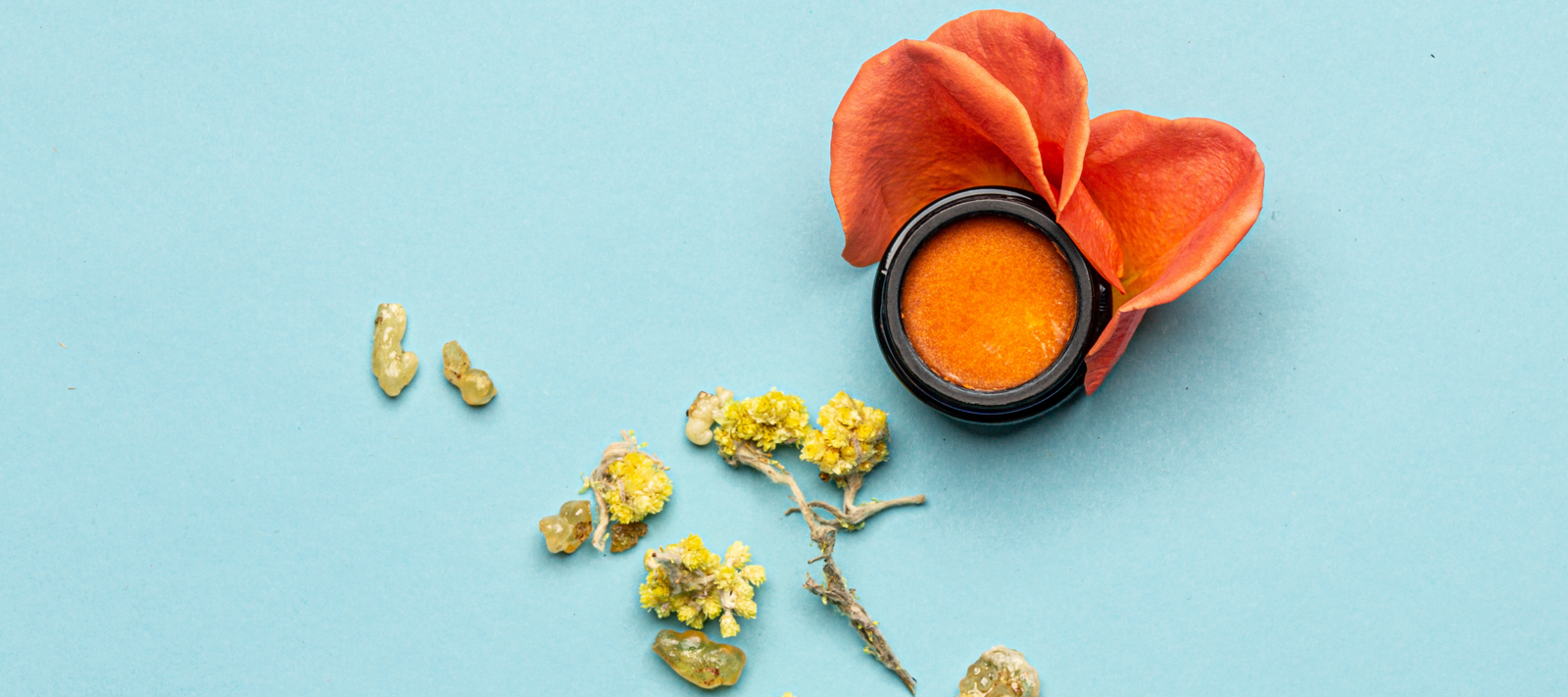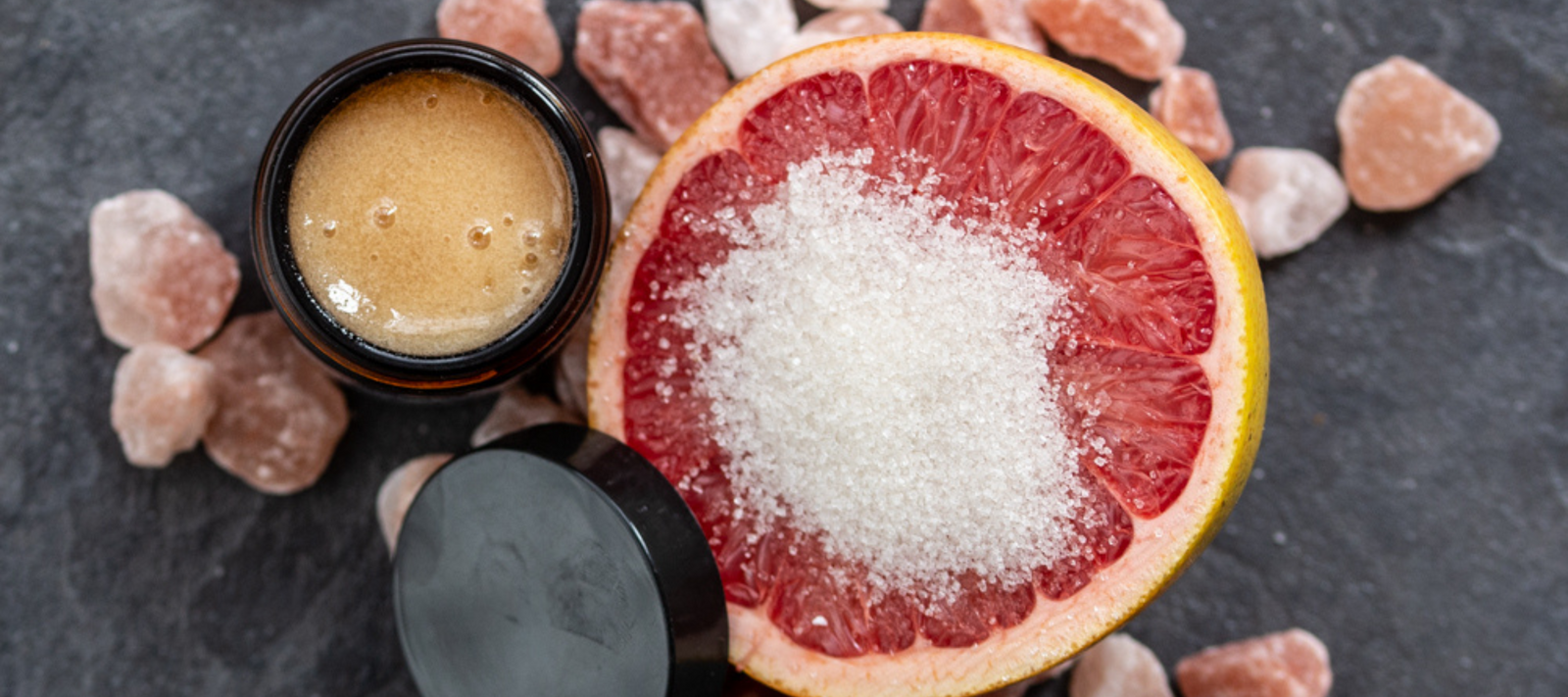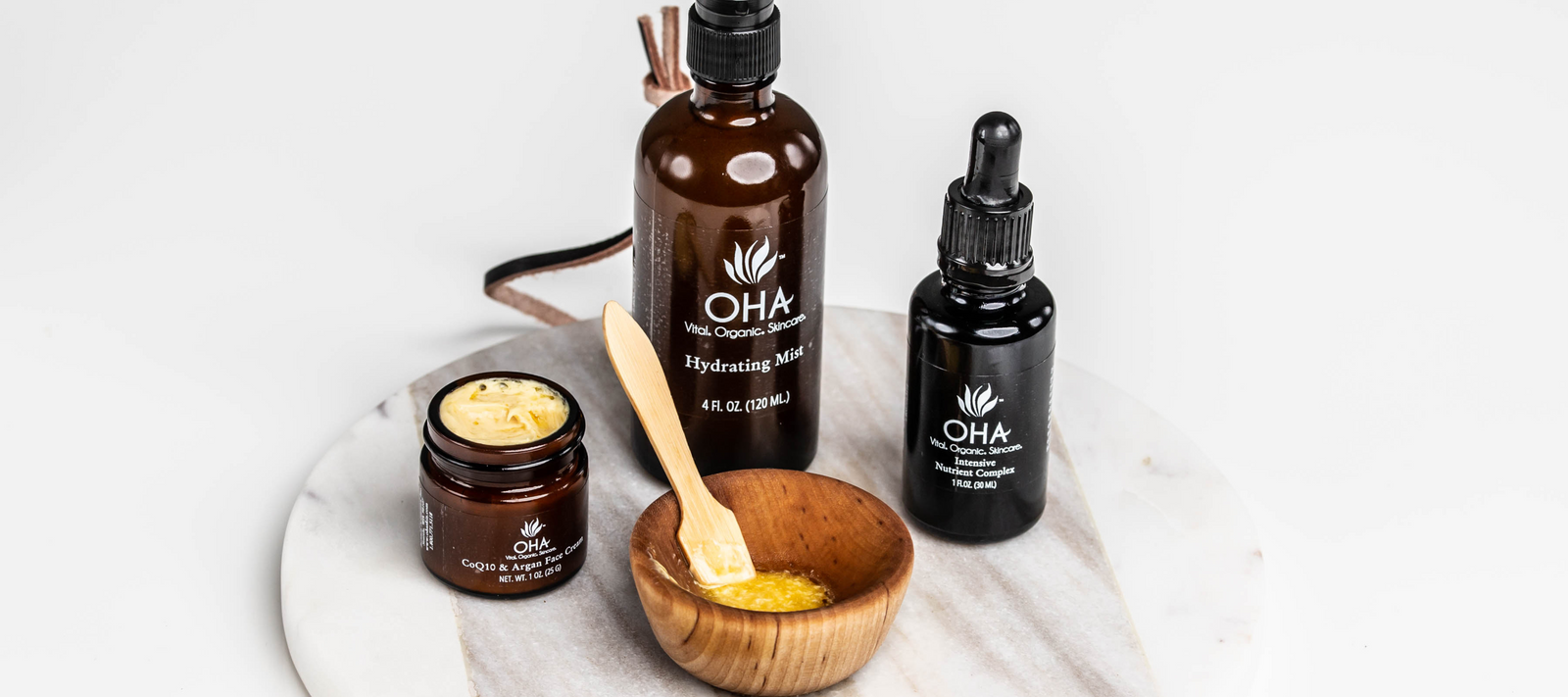Sunscreen is often hailed as the gold standard of skincare, endorsed by dermatologists, celebrities, and beauty bloggers/influencers alike. It’s the most widely recommended product for protecting against harmful UV rays, however, all sunscreens are not created equal.
Here are some reasons to avoid chemical and mineral sunscreens:
Chemical and mineral sunscreens can cause skin reactions and triggersensitivities.Mineral sunscreens, especially those with nano sized particles can pose skin reactions, begin formation of free radicals, leading to premature aging along with causing environmental damage. Chemical sunscreen filters have been associated with health and environmental risks too.
Although the newer chemical filters of avobenzone and octocrylene are safer than oxybenzone, they are not harmless. Avobenzone can degrade in sunlight causing skin damage and cell aging. The chemical octocrylene is used to help stabilize the avobenzone and can degrade into a known carcinogen (benzophenone). Both ingredients have been linked to hormone disruption and allergic reactions. Although not used as often, oxybenzone is still currently being used, in about 9% of sunscreens and is considered one of the most worrisome sunscreen active ingredients.
Environmental concerns:
According to the U.S. National Park Service, an estimated 6,000 to 14,000 tons of sunscreen wash off swimmers and snorkelers into the oceans each year. This pollution poses a significant threat to marine life. Many filters, especially benzophenones, have been deemed persistent, bioaccumulative, and toxic. Benzophenone-3, in particular, is on theEuropean Chemical Agency’s watch list as a potential hormone disruptor. These chemicals have been shown to cause developmental issues in sea urchins and contribute to coral bleaching by disrupting coral DNA and hormone systems. In response, several eco-conscious destinations have banned sunscreens containing harmful ingredients to protect their fragile reefs.
Mineral particles also wash off and tend to sink and accumulate in sand/sediment, where they may affect bottom-dwelling organisms.
Making the case for using Natural Sun Protection
The skincare industry consensus still does not support natural oils as sunscreen alternatives citing they are not 100% reliable. However, that doesn’t mean they don’t work. Even chemical and mineral sunscreens don’t always work. Generally, plant oils are considered UV effective for a two hour time duration.While natural wholeplant oils may not be the best choice for every person and environment involving protection from harmful UV rays, there are many instances, maybe even most instances where they more than perform as well as their chemical and mineral competitors. They offer proven UV protection with many skincare benefits.*
Pro Tip: To get the most reliable sun protection using our Natural Sun Protection we advise the following:
- Limit your exposure to two hours at a time- take a “shade break” for at least 15 minutes if you will be out for more than 2 hours.
- Use in non-peak UV hours from 10:00 am - 2:00 pm.
- Apply 15 minutes before sun exposure.
- Add extra product on “high burn” areas like face, nose, ears, neck, shoulders, hands, and tops of feet. Avoid eye area.
- You can use Natural Sun Protection on your whole body too!
In addition - Shade your skin from the sun
- Limit your exposure to sunlight by wearing clothing that covers your skin, and accessories like hats and scarves.
- Dark and vivid colored, tightly weaved fabrics offer the best protection. However, anything is good! Clothing is the best way to protect yourself from ultraviolet rays.
- Our favorite option is linen. It is light enough to keep you from overheating, while protecting you from the sun. Pair with an enormous, wide brimmed, floppy hat.
*Always follow your doctor’s advice on the use of sunscreen.
OHA’s Natural Sun Protection is more than just SPF.

Benefits of using Natural Sun Protection:
Besides UV protection, whole plant oils are multifunctional, meaning their benefits areantioxidant, moisturizing, and sun protective. This offers your skin support throughout the entire range of sun exposure, pre-sun, active sun exposure, and post sun recovery. As a bonus,using whole plant oils offers anti-aging skincare while being UV protective.
If you do need to continue using a conventional sunscreen, complement it with Natural Sun Protection to boost skin health, for any or all of the pre and post sun range treatments.
Our Natural Sun Protection Lotion is chock-full of Raspberry Seed Oil, carrot seed oil, green tea extract and soothing aloe vera. It is non-greasy, natural, free of chemical smells and is great for sensitive skin. These ingredients have been researched, studied and tested for their SPF values and sun protection benefits.
Red Raspberry Seed Oil
We love Red Raspberry Seed Oil so much that we put it in almost every one of ourmoisturizers. It provides natural UV protection which means all of our moisturizers offer natural sun protection benefits too.* The Natural Sun Protection Lotion has the highest concentration of Red Raspberry Seed Oil, around 15%.
According to one study on Raspberry Seed Oil (Oomah et al 2000), “In the UV-B range, the wavelengths of ultraviolet light responsible for most cellular damage, Raspberry Seed Oil can shield against UV-A induced damage by scattering (high transmission), as well as by absorption. Thus, Raspberry Seed Oil may act as a broad spectrum UV protectant and provide protection against both UV-A, an exogenous origin of oxidative stress to the skin, and UV-B. Raspberry seed oil was comparable to that of titanium dioxide preparations with sun protection factor for UV-B (SPF) and protection factor for UV-A (PFA) values between 28±50 and 6.75±7.5, respectively”.
The most recent study was conducted in 2024 (Ghosh and Dhandha published in SKIN). They found that a 10% concentration of Red Raspberry Seed Oil tested to have an SPF of 20.
Our Red Raspberry Seed Oil comes from a local producer here in the Pacific Northwest.
*All of our whole plant, unrefined oils offer natural SPF UV protection, just not as high as Red Raspberry Seed Oil.
Carrot Seed Oil
A study conducted in 2007 cites Carrot Seed Oil having an SPF of 37-40. A recentVogue article highlights carrot seed oil’s UVB-absorbing compounds (like umbelliferone) and antioxidant properties, but frames them as complementary skincare.
Carrot seed oil contains antioxidants like beta-carotene and vitamin E that help fight UV-induced oxidative damage, contributing to healthier skin.Carrot Seed Oil is a valuable ingredient in any sun protection formula.
Green Tea Extract
Green Tea has been shown to reduce inflammation and protect against UV damage.
Studies show it helps to improve skin elasticity while offering a little bit of SPF protection too. Green Tea contains catechin metabolites which are unique antioxidants called EGCG. They protect your skin from sunburn inflammation and longer-term UVR-mediated damage making it fabulous for skin health and defense.
Our Natural Sun Protection Lotion features a high concentration of this wonder extract. We also carry a Green Tea Cleansing Mist, which is a refreshing pre and post-sun treatment. Many of our other products include green tea extracts, as well.
Aloe Vera
Aloe vera leaf juice is widely recognized for its soothing and healing properties and offers valuable support when it comes to natural sun protection. Rich in antioxidants like vitamins A, C, and E, aloe vera helps combat free radicals generated by UV exposure, reducing oxidative stress on the skin. Its natural anti-inflammatory properties can help calm sun-exposed skin, minimizing redness and irritation.
In 2009, researchers from Ravishankar Shukla University tested a variety of herbal sunscreens and published their results in Pharmacognosy Magazine. They found that pure Aloe Vera, which is what OHA uses, has an SPF of 20. Aloe Vera works synergistically with other natural ingredients to enhance the skin’s resilience against sun damage and promote recovery, making it a powerful ally in any natural sun protection formula.
Note: Aloe Vera is the first medicinal herb documented for its healing uses, dating back to 2100 BC.
If Natural Sun Protection is important to you, incorporate internal boosters to your diet.
Taking supplements, drinking tea, plus eating chocolate and tomatoes.
Astaxanthin supplements
Did you know that taking Astaxanthin supplements daily can greatly increase your natural sun protection and decrease the likelihood of getting a sunburn?
Taking 8-12 mg of astaxanthin daily for nine to sixteen weeks has been shown tosupport photoprotection in studied human trials.
Green Tea
Green tea is another miracle substance! Along with many other potential health benefits, the catechin metabolites in Green Tea can protect your skin from sunburn inflammation and longer-term UVR-mediated damage. These catechins make up quite a bit of the tea, so you only need to drink two cups a day to have noticeable results.
Dark Chocolate
Cocoa flavanols (dark chocolate with high cocoa %) some clinical studies show improved skin blood flow, hydration, and reduced sensitivity to UV.
You need about 20 g (0.7 oz) of high-flavanol cocoa daily - equivalent to a couple of small squares of special high-cacao chocolate or a prepared flavanol supplement.
Most commercial dark chocolate (even 70 - 85%) may only contain 20 - 60 mg flavanols per serving, which is far lower than the amounts shown to help.
Companies likeCocoaVia and some “high-flavanol cocoa powders” sell standardized products that match the studied doses.
Consistency is key - the skin effects appeared after6–12 weeks of daily intake, not immediately.
Tomatoes / tomato paste (lycopene)
Tomatoes are shown in studies to reduce sunburn intensity.
OTHER OHA PRODUCTS FOR SUN PROTECTION AND DEFENSE AGAINST SKIN AGING
The two biggest reasons people use a sun protective product is to avoid skin cancer and to reduce visible signs of skin aging. 90% of skin aging is attributable to sun exposure. In response to these large concerns OHA offers two other targeted productsto meet these challenges:

These two products have a special anti-aging, sun protection ingredient in common.This ingredient is called Astaxanthin. Astaxanthin is a tinted red carotenoid that occurs naturally in marine life. Fun Fact: Astaxanthin is what gives flamingos, and other animals such as shrimp and salmon, their unique pink color.
Astaxanthin protects your skin from the sun by scavenging the free-radicals that cause damage. It is stored in your skin, and is distributed through all of the layers, providing deep protection. Sunscreen only protects the top layers of skin, and washes off easily. This provides wonderful, consistent protection against ultraviolet radiation, which is the most powerful environmental risk factor for skin cancer.
Recent studies show that topical use of Astaxanthin provides photoprotection-reducing UV induced redness and cellular damage.
Another was a human pilot study where after 24 hours, both visual assessment and colorimetric measurements showed thatthe treated areas exhibited significantly reduced erythema (redness) compared to placebo-treated skin.
Besides being sun protective, Astaxanthin is an antioxidant, proven to reduce wrinkles and dark spots. It also increases elasticity plus lends a subtle healthy color tint to your skin.
Sun protection yes, but don’t avoid the sun completely
Sunshine is actually good for you. Getting a little sun has some great benefits! Exposure to sunlight increases your Vitamin D. Vitamin D deficiency has been linked to breast cancer and colorectal cancer. 10-15 minutes of sunshine a day is recommended for getting your Vitamin D.
Other benefits of sunshine include helping you sleep, raising levels of serotonin- and thus improving your mood and energy level, lowering blood pressure, andprotectingyou from melanoma.
At the end of the day, sun protection on your skin doesn't have to mean loading it with harsh chemicals and minerals. With powerful plant-based ingredients like Raspberry Seed Oil, Aloe Vera, Green Tea, and Astaxanthin, our gentle and effective formulas got you covered. Try them for yourself and feel the difference. www.ohaskin.com
Pro Tip 1:
Apply to clean, damp skin Extra Sun Protection Skin Layering Mix:
- 3-5 sprays Green Tea Cleansing Mist
- 1 pump of Advanced Super Serum *
- Pea sized amount Radiant Light Facial Balm
- Mix in the palm of your hand and apply upward strokes to the face, neck and
- Include your decolotte
- Top off for extra protection:
- Apply a dime size amount of Natural Sun Protection as a top layer to this mixture, covering your face and neck.
*= Remember to shake the Advanced Super Serum 20 times before application.
Pro Tip 2:
Apply to clean, damp skin Every Day Sun Protection Mix:
- 3-5 sprays of Green Tea Cleansing Mist
- 1 pump of Advanced Super Serum *
- Pea sized amount of Natural Sun Protection mixed with
- 1 small pump of OHA moisturizer of your choice
- Mix in palm of your hand and apply upward strokes to face, neck and decollete
*= Remember to shake the Advanced Super Serum 20 times before application
Pro Tip 3:
Apply to clean, damp skin Minimalist Sun Protection Mix:
- 3-5 sprays Green Tea Cleansing Mist
- Dime amount of Natural Sun Protection
- Mix in palm of your hand and apply upward strokes to face, neck and decollete
Sources:
Oxybenzonehttps://www.truthinaging.com/ingredients/oxybenzone
Do sunscreens Prevent or Cause Cancer?http://www.chrisbeatcancer.com/do-sunscreens-prevent-cancer-or-cause-it/
Do Sunscreens' Tiny Particles Harm Ocean Life in Big Ways?http://news.nationalgeographic.com/2015/05/150514-sunscreen-nanoparticle-nanotechnology-oceans-marine-beach-boat-toxic/
How Sunscreen May be Destroying Coral Reefshttp://time.com/4080985/sunscreen-coral-reefs/
Sun Exposure: Vitamin D And Other Health Benefits Of Sunlighthttp://www.medicaldaily.com/sun-exposure-vitamin-d-and-other-health-benefits-sunlight-246487
Astaxanthin Provides Broad Spectrum Protectionhttp://www.lifeextension.com/magazine/2013/4/Astaxanthin-Provides-Broad-Spectrum-Protection/Page-01
Astaxanthinhttps://examine.com/supplements/astaxanthin/
Oral green tea catechin metabolites are incorporated into human skin and protect against UV radiation-induced cutaneous inflammation in association with reduced production of pro-inflammatory eicosanoid 12-hydroxyeicosatetraenoic acidhttp://journals.cambridge.org/action/displayAbstract?fromPage=online&aid=8976471&fileId=S0007114512006071
Characteristics of raspberry (Rubus idaeus L.) seed oilhttp://www.berrybeautiful.us/assets/characteristics-of-raspberry-%28rubus-idaeus-l.%29-seed-oil.pdf
What is Sunsafe Clothing?http://www.skincancer.org/prevention/sun-protection/clothing/protection



